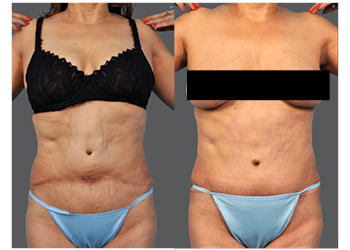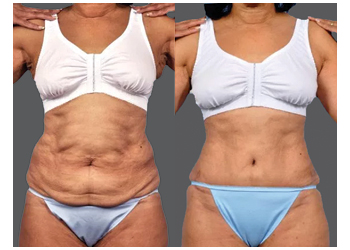What you can do to get the best results from your cosmetic surgery
You don’t always get the results they expected from cosmetic surgery, which can leave you disheartened, especially when you have to spend more time and money to change the outcome. You need to take a proactive role in your procedure from start to finish, because there are things you can do to prevent or resolve disappointing results. Dr. Christopher Knotts of Austin-Weston, The Center for Cosmetic Surgery shared some stories about what can go wrong and what patients can do to ensure the best possible outcome.
Prevent a Minor Complication from Becoming Something Bigger
A woman came to Dr. Knotts several years after returning to her native South America for a tummy tuck. He noticed right away that her incision was quite high.
“The incision was halfway between her underwear and the belly button. Normally, we try to put it low, where it hides under underwear,” Knotts said. However, the patient’s main complaint was a feeling of fullness in her upper abdomen. When she pushed on it, it felt like a water balloon. She knew something was wrong. She just didn’t know what.
The patient had a seroma—a collection of fluid under the skin—which is a very common complication following any type of liposuction. During follow-up visits after surgery, a doctor usually recognizes this complication, and drains the fluid with a needle.
“If it’s not diagnosed, and it sits in there for years, your body will heal around it, and it’s like a little purse or a water balloon,” said Knotts. Because this patient went to another country, and she only stayed for a week or two, she did not receive the appropriate post-surgical follow-up. “The planning of the surgery wasn’t good, the position of the incision,” said Knotts, “but a seroma itself is not a terrible thing.”
Once the body forms a sack around the seroma, if a doctor tries to drain it, it will fill back up. The only way to remove it is with surgery. Dr. Knotts operated, and the patient wound up with a low incision and a flat abdomen.
Patients often travel to have procedures, but to prevent a mild complication from turning into something more serious, you want your surgeon nearby for post-op checks and in case you notice anything that doesn’t seem right. Trust your instincts. You know your body better than anyone. “You’ll know about most serious complications once you get to about three weeks out,” said Knotts.
Patient 1

“..the patient’s main complaint was a feeling of fullness in her upper abdomen. When she pushed on it, it felt like a water balloon.”
Choose the Right Procedure
In addition to making sure you have surgical follow-up appointments, you need to make sure the procedure you’re getting is the right one for you. A patient presented to Dr. Knotts with a lumpy and bumpy abdomen following CoolSculpting. This minimally invasive procedure freezes fat cells that your body then sheds. Too much of the procedure, or if it’s done on someone with a little extra skin, can actually make the area look worse.
“This patient really needed skin removal, not CoolSculpting,” said Knotts. “It’s not necessarily a terrible complication of CoolSculpting, it’s just a case of going to a medical spa where the only thing they offer is CoolSculpting.” Dr. Knotts removed the patient’s excess skin, and she got a nice flat result.
The lesson here is to shop around. You may hear about a procedure and know someone who had it with great results, but everybody is different, so you need to get advice about what is best for you. We have an abundance of plastic surgeons in our area, so make appointments for a couple consultations. If the medspa and two doctors all say you would benefit from the same procedure, then that probably is what you need. But if there’s disagreement, dig deeper. Ask them why they think you’re a good or bad candidate for a certain procedure and what the alternatives are.
Once you’ve identified the right procedure, have it done somewhere that specializes in what you want. They are more likely to know how to get the best results and will be more familiar with typical complications from the procedure. Don’t be afraid to ask the surgeon about how much experience he or she has with the particular procedure you’re considering and discuss the plan for your procedure. Poorly planned cosmetic surgery often results in visible scars.
Patient 2

“This patient really needed skin removal, not CoolSculpting,” Dr. Knotts removed the patient’s excess skin, and she got a nice flat result.”
Find the Right Practitioner
An unusual complication that Dr. Knotts has seen twice in the last year was infected filler. In both cases, the patients—who didn’t know each other—had gone to Thailand for their procedures. “Once you have something foreign in your body that’s infected, it will never resolve as long as there is something foreign present,” he said. Not only did the patients need antibiotics for six months, but the filler had to be removed. “Luckily, it was dissolvable, but it took five or six sessions of dissolving to get rid of it all.”
Finding an experienced, qualified and highly rated practitioner is the best thing you can do for yourself when considering any sort of procedure. Start by checking with friends and family members for recommendations. If you know several people who recommend a certain practice or doctor who they liked and had good results with, then you meet and feel comfortable with the doctor, then your work is done.
Don’t worry about insulting a doctor by getting a second opinion. They understand. It’s part of their business. Not only can it help you know you’re getting the right procedure, but it’s important for you to feel comfortable with your surgeon. Dr. Knotts recommends asking yourself, “If I had a problem—because anyone can have a problem—is this the person I’d want taking care of me?”
If you’re having a noninvasive procedure that doesn’t require a doctor, know that different states have different licensing and oversight regulations, and they change frequently. Check out reviews online, ask the practice about their state certifications and check with your state or local agencies about any complaints against the business.
If you are using a doctor, check that your doctor is certified by a board recognized by the American Board of Medical Specialties (ABMS). The ABMS recognizes a small subset of boards with strict standards such as the American Board of Plastic Surgery (ABPS), the American Board of Dermatology and others. The ABPS is the only plastic surgery or cosmetic surgery organization in the United States recognized by the ABMS. You can verify your surgeon’s board certification by visiting www.abplsurg.org.
Even if you’re having an in-office procedure, check that your surgeon has operating privileges in an accredited hospital for the same procedure you’re considering. Hospital review committees evaluate a surgeon’s training and competency for specific procedures before they grant operating privileges.
If you’re thinking about having plastic surgery, doing your homework and advocating for yourself can ensure that you’re getting the right procedure and the best care that will get you the results you’re looking for.






